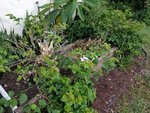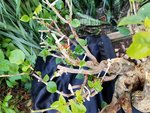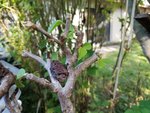SU2
Omono
I just pulled yet another tree (bougie) that'd grown to a bush the past quarter-year and I hard-pruned its canopy however I look at the 'nekkid bones' of this guy and am worrying I've got something wrong, have posted elsewhere about it and someone mentioned something I'd pondered which is simply too many branches IE while ramification is good, it's for the outer-edges of the canopy, and that the problem with my approach so far has been that I'm allowing *too many* branches to run (meaning that when I hard-prune I'm shortening everything, but removing almost no branches, I maybe removed 10 or 15 from this guy while working him over the past week and am suspecting I should've removed double, even triple that)
Here's a photo close-up of a 'pad' (am I using that right?) from the specimen I'm talking about:

(will post more pics of this tree at end-of-post)
Aaaand here's a photo/screenshot from a video I was just watching where I saw some branch-pads that were, essentially, what I'm aiming for (although to be fair I'm actually aiming for a tighter canopy than shown but not by that much)

So if I'm going for something like ^that, and my growing-approach is just "let them bush-out, then cut-back hard, rinse&repeat til you hit the In-Refinement stage", what about my results so far should I be trying to change? Am guessing branch-density but then when I look at this I don't see that it's got any fewer branches-per-inch in the canopy so I dunno, maybe I am on-point? (oh and on that note, while I welcome & actually love critiques, I'd appreciate context/quantification if at all possible, like instead of "too many branches" it'd be far more helpful to hear "just a bit, 1/5tth maybe, too-many branches" or "too many branches, at least by double", *anything* that lets me contextualize your reply for its severity/quantity
~~~~~~~~~~~~~
Some more photos of the tree I'm finishing-up now, this guy's had a few summers' growth and has filled in nicely (IMO) and I kinda thought summer 2020 would be 'its year' IE swap-over from Development to Refinement but if I've gotten something majorly wrong in buildling my branch-structure then I'll need another year to correct it
These photos were taken in an order & at angles that I thought would be most-illustrative of the tree/its pads, thing doesn't lend itself to photography well
in-bed still:
whole tree in its summer grow-out bed:
birdseye view of branch-pads with black backdrop:
A handful more of the individual pads' close-ups:


The tree is meant to have 1 large top canopy spanning the entire container, though it'll be made of 30/70% left-side-canopy // right-side-canopy, just due to how much trunk-mass is on either side. At least one of the upper pinnacles of the trunk (and its corresponding branch/primary) will be removed as a couple clash with each other, just haven't decided which to ditch yet...Then there's those two lower, side-of-trunk pads, they kinda reach-towards the camera in "front shots", at any rate those will each be their own 'pad', distinct from the upper canopy & from each other. All of this is being done with a focus on having as-much-as-possible of the trunk's body showing, love this trunk & don't want to hide any of it!!
~~~~~~~~~~
Again thanks a ton for any&all thoughts on this, I'm genuinely happy to get anything from "looks weird" to "I like it" to, obviously, thought-out answers on styling, but yeah any&all criticism, positive or negative, would be greatly appreciated (and obviously will answer Q's, am sure the zip-ties pop-out at people lol, they work for me [I wire as well they're just 1 tool in the kit!] so I make-use of them whenever I can!)
Here's a photo close-up of a 'pad' (am I using that right?) from the specimen I'm talking about:

(will post more pics of this tree at end-of-post)
Aaaand here's a photo/screenshot from a video I was just watching where I saw some branch-pads that were, essentially, what I'm aiming for (although to be fair I'm actually aiming for a tighter canopy than shown but not by that much)

So if I'm going for something like ^that, and my growing-approach is just "let them bush-out, then cut-back hard, rinse&repeat til you hit the In-Refinement stage", what about my results so far should I be trying to change? Am guessing branch-density but then when I look at this I don't see that it's got any fewer branches-per-inch in the canopy so I dunno, maybe I am on-point? (oh and on that note, while I welcome & actually love critiques, I'd appreciate context/quantification if at all possible, like instead of "too many branches" it'd be far more helpful to hear "just a bit, 1/5tth maybe, too-many branches" or "too many branches, at least by double", *anything* that lets me contextualize your reply for its severity/quantity
~~~~~~~~~~~~~
Some more photos of the tree I'm finishing-up now, this guy's had a few summers' growth and has filled in nicely (IMO) and I kinda thought summer 2020 would be 'its year' IE swap-over from Development to Refinement but if I've gotten something majorly wrong in buildling my branch-structure then I'll need another year to correct it
These photos were taken in an order & at angles that I thought would be most-illustrative of the tree/its pads, thing doesn't lend itself to photography well
in-bed still:

whole tree in its summer grow-out bed:

birdseye view of branch-pads with black backdrop:

A handful more of the individual pads' close-ups:



The tree is meant to have 1 large top canopy spanning the entire container, though it'll be made of 30/70% left-side-canopy // right-side-canopy, just due to how much trunk-mass is on either side. At least one of the upper pinnacles of the trunk (and its corresponding branch/primary) will be removed as a couple clash with each other, just haven't decided which to ditch yet...Then there's those two lower, side-of-trunk pads, they kinda reach-towards the camera in "front shots", at any rate those will each be their own 'pad', distinct from the upper canopy & from each other. All of this is being done with a focus on having as-much-as-possible of the trunk's body showing, love this trunk & don't want to hide any of it!!
~~~~~~~~~~
Again thanks a ton for any&all thoughts on this, I'm genuinely happy to get anything from "looks weird" to "I like it" to, obviously, thought-out answers on styling, but yeah any&all criticism, positive or negative, would be greatly appreciated (and obviously will answer Q's, am sure the zip-ties pop-out at people lol, they work for me [I wire as well they're just 1 tool in the kit!] so I make-use of them whenever I can!)









